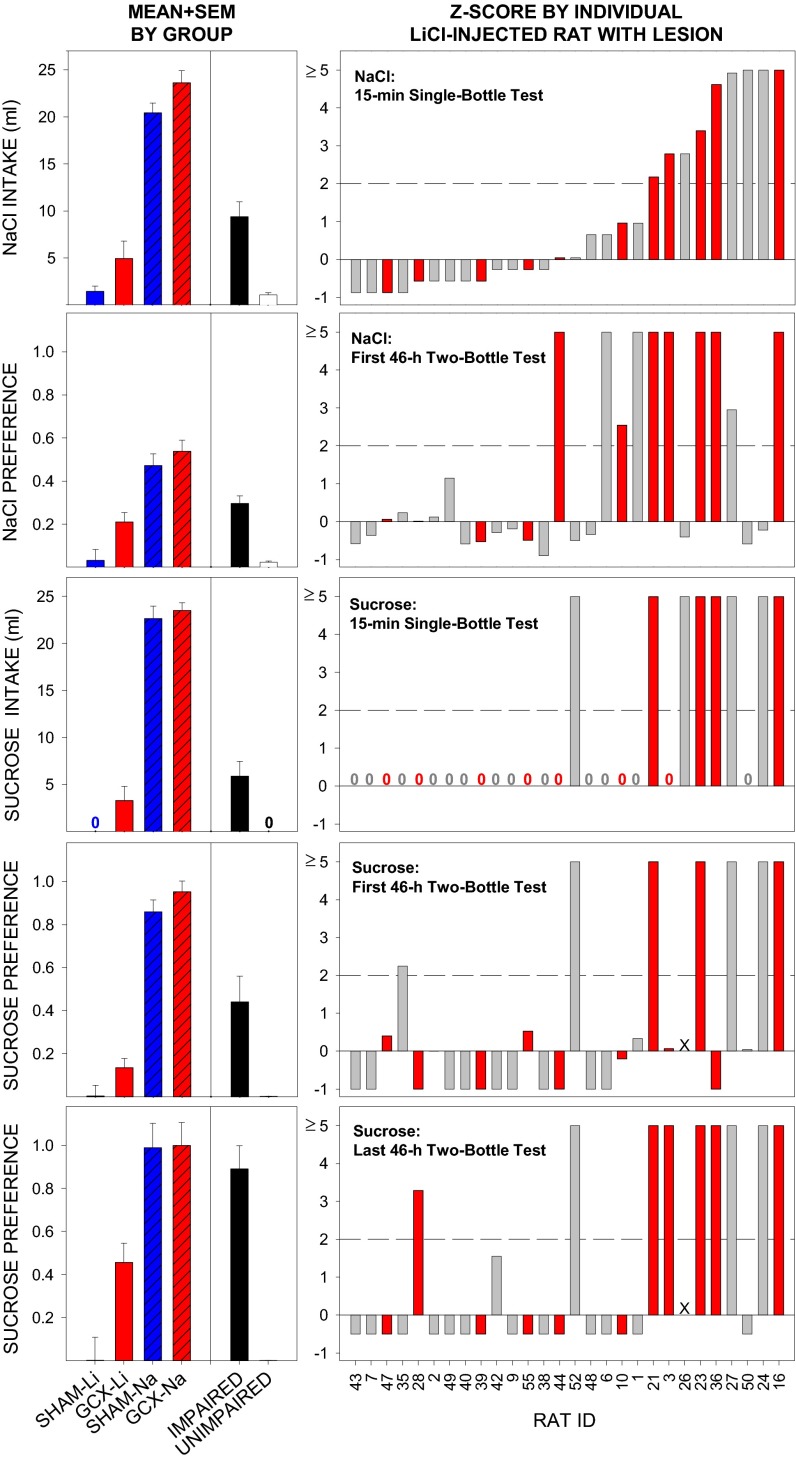Fig. 1.
Left panels, left of the black vertical line: Mean + SEM intake or preference score for the LiCl- and NaCl-injected rats that met the lesion-based criterion (≥50% bilateral damage to GC: GCX-Li, n = 11; GCX-Na, n = 8) and the sham-operated controls (SHAM-Li, n = 8; SHAM-Na, n = 7) across CTA measures (vertical panels). Although both GCX groups drank slightly more NaCl on the 15-min single-bottle retention test [effect of Lesion: F(1,30) = 5.28, P = 0.03), both GCX-Li and SHAM-Li rats consumed significantly less than did their NaCl-injected counterparts, as indicated by a significant effect of US [F(1,30) = 166.26, P ≤ 0.00001] that did not further interact with Lesion [US × Lesion: F(1,30) = 0.01, P = 0.91]. Similar patterns were found on the first 46-h NaCl two-bottle test [Lesion: F(1,30) = 5.96, P = 0.02; US: F(1,30) = 58.33, P ≤ 0.00001; US × Lesion: F(1,30) = 1.24, P = 0.27], 15-min single-bottle sucrose test, and first 46-h sucrose-two bottle test [Lesion: F(1,30) = 5.03, P = 0.03; US: F(1,30) = 282.37, P ≤ 0.00001; US × Lesion: F(1,30) = 0.16, P = 0.69]. Because none of the rats in the SHAM-Li group consumed any sucrose on the 15-min single-bottle test (hence no bar, 0), a series of nonparametric Mann–Whitney U tests were conducted (SHAM-Li versus GCX-Li: U = 60.0, P = 0.19; SHAM-Li versus SHAM-Na: U = 0, P ≤ 0.003; GCX-Li versus GCX-Na: U = 0, P ≤ 0.003; Bonferroni-corrected). By the final 46-h sucrose two-bottle test, however, the preference for sucrose had increased in the GCX-Li group, but not in the SHAM-Li group [Lesion: F(1,30) = 4.94, P = 0.03; US: F(1,30) = 53.74, P < 0.00001; Lesion × US: F(1,30) = 4.48, P = 0.04]. Post hoc independent t tests (all Bonferroni-corrected for multiple comparisons) following up on the Lesion × US interaction showed that SHAM-Na and GCX-Na rats had a higher preference for sucrose than SHAM-Li rats (values of P < 0.00006). Even though there was no difference between SHAM-Li and GCX-Li rats (P = 0.18), preference for sucrose in the GCX-Li group had increased somewhat and was no longer statistically different from the SHAM-Na group (P = 0.12). Left panels, right of the black vertical line: Mean + SEM intake or preference score for groups of rats with lesions, irrespective of lesion size or placement that were considered IMPAIRED (≥2 SDs from mean of the SHAM-Li group) or UNIMPAIRED for each CTA test. (Right) Standardized degree of impairment (Z score relative to mean and SD of SHAM-Li group) on each major CTA test plotted as a function of individual rat with a lesion. Rats that met the GCX criterion are colored in red. The y-axis scales are capped at 5.0 for presentation purposes. Numerical digit 0 is displayed above the x axis when the Z score of a given rat equaled zero. Rat 26 was excluded from the first and last 46-h sucrose two-bottle tests (due to illness, X = no data). Pearson’s correlation tests (all Bonferroni-corrected for multiple comparisons) indicated that degree of impairment on the 15-min NaCl single-bottle test was significantly positively correlated with degree of impairment on the 15-min sucrose single-bottle test (r = 0.71, P = 0.002, n = 28), and the last 46-h two-bottle preference test with sucrose (r = 0.69, P = 0.002, n = 27). Impairment on the first 46-h two-bottle test with NaCl was significantly positively correlated with impairment on the 15-min single-bottle retention test for sucrose (r = 0.53, P = 0.05, n = 28).

